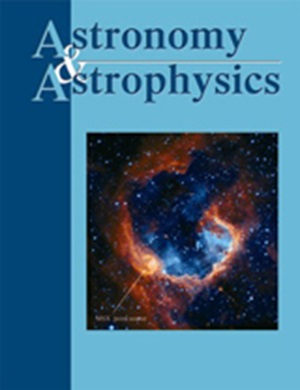OTELO 调查
IF 5.8
2区 物理与天体物理
引用次数: 2
摘要
背景。我们从质量-金属性关系(MZR)及其可能的演化角度,研究了z∼0.4的低质量Hα发射线源样本。我们的样本来自OSIRIS可调发射线天体(OTELO)巡天,该巡天利用加那利大望远镜(Gran Telescopio Canarias)的OSIRIS红色可调滤光片,对扩展格罗斯带(Extended Groth Strip)的选定区域进行盲窄带光谱扫描。通过分析 OTELO 伪光谱,我们能够直接测量发射线通量和等效宽度。这项研究旨在探索超低质量的MZR。我们的样本恒星质量(M*)低至106.8 M⊙,其中63%的样本M* < 109 M⊙。我们还探讨了恒星形成率(SFR)和比SFR与M*和气相氧丰度的关系,以及M*-大小关系和形态分类。利用合成静帧颜色估算 M*。利用χ2最小化方法,我们分离了[N II]λ6583 对 Hα 辐射线的贡献。利用 N2 指数,我们从恒星形成星系(SFG)中分离出了活动星系核,并估算了气体金属度。我们利用哈勃太空望远镜-ACS 的高分辨率数据,定性(目测)和定量(自动)地研究了采样星系的形态。星系的物理大小是通过使用 GALAPAGOS2/GALFIT 进行形态分析得出的,我们为每个星系源拟合了一个单一的塞里斯二维模型。通过将我们的超低质量样本与斯隆数字巡天中的本地SFG进行比较,我们没有发现MZR演化的证据。此外,通过与近期文献的比较,我们推断M*大小和M*-SFR关系也是如此。从形态上看,我们的样本大部分(63%)是晚期类型的星系,13%是早期类型的星系。我们首次在 z = 0.4 的 MZR 中发现了一个可能的候选离群点。这个星源的恒星质量、金属性、颜色、形态和SFR都表明它与一个过渡矮星系相吻合。本文章由计算机程序翻译,如有差异,请以英文原文为准。
The OTELO survey
Context. A sample of low-mass Hα emission line sources at z ∼ 0.4 was studied in the context of the mass-metallicty relation (MZR) and its possible evolution. We drew our sample from the OSIRIS Tunable Emission Line Object (OTELO) survey, which exploits the red tunable filter of OSIRIS at the Gran Telescopio Canarias to perform a blind narrow-band spectral scan in a selected field of the Extended Groth Strip. We were able to directly measure emission line fluxes and equivalent widths from the analysis of OTELO pseudo-spectra.
Aims. This study aims to explore the MZR in the very low-mass regime. Our sample reaches stellar masses (M*) as low as 106.8 M⊙, where 63% of the sample have M* < 109 M⊙. We also explore the relation of the star formation rate (SFR) and specific SFR with M* and gas-phase oxygen abundances, as well as the M*-size relation and the morphological classification.
Methods. The M* were estimated using synthetic rest-frame colours. Using an χ2 minimization method, we separated the contribution of [N II]λ6583 to the Hα emission lines. Using the N2 index, we separated active galactic nuclei from star-forming galaxies (SFGs) and estimated the gas metallicity. We studied the morphology of the sampled galaxies qualitatively (visually) and quantitatively (automatically) using high-resolution data from the Hubble Space Telescope-ACS. The physical size of the galaxies was derived from the morphological analysis using GALAPAGOS2/GALFIT, where we fit a single-Sérsic 2D model to each source.
Results. We find no evidence for an MZR evolution from comparing our very low-mass sample with local SFGs from the Sloan Digital Sky Survey. Furthermore, the same is true for M*-size and M*-SFR relations, as we deduce from comparison with recent literature. Morphologically, our sample is mostly (63%) populated by late-type galaxies, with 13% of early-type sources. For the first time, we identify one possible candidate outlier in the MZR at z = 0.4. The stellar-mass, metallicity, colour, morphology, and SFR of this source suggest that it is compatible with a transitional dwarf galaxy.
求助全文
通过发布文献求助,成功后即可免费获取论文全文。
去求助
来源期刊

Astronomy & Astrophysics
ASTRONOMY & ASTROPHYSICS-
自引率
27.70%
发文量
0
期刊介绍:
Astronomy & Astrophysics is an international Journal that publishes papers on all aspects of astronomy and astrophysics (theoretical, observational, and instrumental) independently of the techniques used to obtain the results.
 求助内容:
求助内容: 应助结果提醒方式:
应助结果提醒方式:


